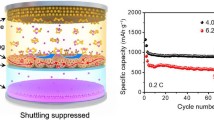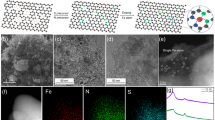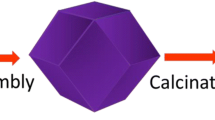Abstract
Single-atomic catalysts consisting of atomically dispersed metal sites within nitrogen-doped carbon matrix (M SAC@NC) have emerged as high-performance electrocatalytic materials in Li-S batteries due to their maximum atom utilization, unique physicochemical properties, and superior catalytic activity. In the present work, a series of M SAC@NC (M = Ni, Co, Fe) with similar structural and physicochemical properties have been successfully prepared by the combination of physical adsorption and pyrolysis. The combination of the aberration-corrected high-angle annular dark-field scanning transmission electron microscopy and X-ray adsorption spectra indicates the successful formation of single-atomic metal sites. Moreover, the catalytic activity trend toward sulfur redox reaction is observed to be Ni SAC@NC > Co SAC@NC > Fe SAC@NC, and the Ni SAC@NC delivers the highest capacity of 1,280.6 mAh g−1 and long-time stability at a decay rate of 0.07% per cycle for 800 cycles at 0.5 C, demonstrating excellent battery performance.

摘要
由分散在氮掺杂碳载体上的原子级金属位点组成的单原子催化剂(M SAC@NC) 因其具有最大的原子利用率、 独特的物理化学性质和优异的催化活性, 已成为Li-S电池中的高性能电催化材料. 本文采用物理吸附和热解相结合的方法, 成功制备了一系列具有相似结构和理化性质的M SAC@NC (M = Ni, Co, Fe). 双球差校正高角环形暗场扫描透射电子显微镜和X射线吸收光谱表明成功形成了单原子金属位点. 此外, 对硫氧化还原反应的催化活性趋势为Ni SAC@NC > Co SAC@NC > Fe SAC@NC, 其中Ni SAC@NC在0.5 C下表现出1280.6 mAh g−1的最高容量, 循环800次后, 平均每圈容量衰减率仅为0.07%, 具有优异的电池性能.
Similar content being viewed by others
References
Imoisili PE, Ren J, Jen TC. Single-atom catalysts for lithium sulfur batteries via atomic layer deposition process. Electrochem Commun, 2022, 135: 107215
Bruce PG, Freunberger SA, Hardwick LJ, et al. Li-O2 and Li-S batteries with high energy storage. Nat Mater, 2012, 11: 19–29
Yin YX, Xin S, Guo YG, et al. Lithium-sulfur batteries: electrochemistry, materials, and prospects. Angew Chem Int Ed, 2013, 52: 13186–13200
Xin S, Zhang X, Wang L, et al. Roadmap for rechargeable batteries: present and beyond. Sci China Chem, 2024, 67: 13–42
Fang R, Zhao S, Sun Z, et al. More reliable lithium-sulfur batteries: status, solutions and prospects. Adv Mater, 2017, 29: 1606823
Bhargav A, He J, Gupta A, et al. Lithium-sulfur batteries: attaining the critical metrics. Joule, 2020, 4: 285–291
Xue W, Shi Z, Suo L, et al. Intercalation-conversion hybrid cathodes enabling Li-S full-cell architectures with jointly superior gravimetric and volumetric energy densities. Nat Energy, 2019, 4: 374–382
Chen J, Zhang Y, Yang J, et al. Post lithium-sulfur battery era: challenges and opportunities towards practical application. Sci China Chem, 2024, 67: 106–121
Ji X, Lee KT, Nazar LF. A highly ordered nanostructured carbon-sulphur cathode for lithium-sulphur batteries. Nat Mater, 2009, 8: 500–506
Pei F, Lin L, Ou D, et al. Self-supporting sulfur cathodes enabled by two-dimensional carbon yolk-shell nanosheets for high-energy-density lithium-sulfur batteries. Nat Commun, 2017, 8: 482
Yang A, Zhou G, Kong X, et al. Electrochemical generation of liquid and solid sulfur on two-dimensional layered materials with distinct areal capacities. Nat Nanotechnol, 2020, 15: 231–237
Barragán-Iglesias P, Lou TF, Bhat VD, et al. Inhibition of poly(A)-binding protein with a synthetic RNA mimic reduces pain sensitization in mice. Nat Commun, 2018, 9: 10
Yu J, Xiao J, Li A, et al. Enhanced multiple anchoring and catalytic conversion of polysulfides by amorphous MoS3 nanoboxes for highperformance Li-S batteries. Angew Chem Int Ed, 2020, 59: 13071–13078
Al Salem H, Babu G, V. Rao C, et al. Electrocatalytic polysulfide traps for controlling redox shuttle process of Li-S batteries. J Am Chem Soc, 2015, 137: 11542–11545
Liu D, Zhang C, Zhou G, et al. Catalytic effects in lithium-sulfur batteries: promoted sulfur transformation and reduced shuttle effect. Adv Sci, 2018, 5: 1700270
Geng C, Hua W, Wang D, et al. Demystifying the catalysis in lithium-sulfur batteries: characterization methods and techniques. SusMat, 2021, 1: 51–65
Primbs M, Sun Y, Roy A, et al. Establishing reactivity descriptors for platinum group metal (PGM)-free Fe-N-C catalysts for PEM fuel cells. Energy Environ Sci, 2020, 13: 2480–2500
Du L, Xing L, Zhang G, et al. Engineering of electrocatalyst/electrolyte interface for ambient ammonia synthesis. SusMat, 2021, 1: 150–173
Ma F, Wan Y, Wang X, et al. Bifunctional atomically dispersed Mo-N2/C nanosheets boost lithium sulfide deposition/decomposition for stable lithium-sulfur batteries. ACS Nano, 2020, 14: 10115–10126
Wang P, Xi B, Zhang Z, et al. Atomic tungsten on graphene with unique coordination enabling kinetically boosted lithium-sulfur batteries. Angew Chem Int Ed, 2021, 60: 15563–15571
Zhang L, Liang P, Shu HB, et al. Design rules of heteroatom-doped graphene to achieve high performance lithium-sulfur batteries: both strong anchoring and catalysing based on first principles calculation. J Colloid Interface Sci, 2018, 529: 426–431
Zhang T, Chen Z, Zhao J, et al. Metal-N4/graphene as an efficient anchoring material for lithium-sulfur batteries: a computational study. Diamond Relat Mater, 2018, 90: 72–78
Zhou G, Zhao S, Wang T, et al. Theoretical calculation guided design of single-atom catalysts toward fast kinetic and long-life Li-S batteries. Nano Lett, 2020, 20: 1252–1261
Liang HJ, Gu ZY, Zheng XY, et al. Tempura-like carbon/carbon composite as advanced anode materials for K-ion batteries. J Energy Chem, 2021, 59: 589–598
Xiao R, Yu T, Yang S, et al. Electronic structure adjustment of lithium sulfide by a single-atom copper catalyst toward high-rate lithium-sulfur batteries. Energy Storage Mater, 2022, 51: 890–899
Xiao C, Song W, Liang J, et al. P-block tin single atom catalyst for improved electrochemistry in a lithium-sulfur battery: a theoretical and experimental study. J Mater Chem A, 2022, 10: 3667–3677
Zhang Y, Kang C, Zhao W, et al. d-p hybridization-induced “trapping-coupling-conversion” enables high-efficiency Nb single-atom catalysis for Li-S batteries. J Am Chem Soc, 2023, 145: 1728–1739
Yang X, Wang YY, Hou BH, et al. Nano-SnO2 decorated carbon cloth as flexible, self-supporting and additive-free anode for sodium/lithium-ion batteries. Acta Metall Sin (Engl Lett), 2021, 34: 390–400
Luo XX, Li WH, Liang HJ, et al. Covalent organic framework with highly accessible carbonyls and π-cation effect for advanced potassium-ion batteries. Angew Chem Int Ed, 2022, 61: e202117661
Yang Z, Zhao Z, Zhou H, et al. Cobalt-based double catalytic sites on mesoporous carbon as reversible polysulfide catalysts for fast-kinetic Li-S batteries. ACS Appl Mater Interfaces, 2021, 13: 51174–51185
Gao Y, Wu T, Yang C, et al. Activity trends and mechanisms in per-oxymonosulfate-assisted catalytic production of singlet oxygen over atomic metal-N-C catalysts. Angew Chem Int Ed, 2021, 60: 22513–22521
Wan X, Liu X, Li Y, et al. Fe-N-C electrocatalyst with dense active sites and efficient mass transport for high-performance proton exchange membrane fuel cells. Nat Catal, 2019, 2: 259–268
Li Z, Huang Y, Yuan L, et al. Status and prospects in sulfur-carbon composites as cathode materials for rechargeable lithium-sulfur batteries. Carbon, 2015, 92: 41–63
Wang M, Xia X, Zhong Y, et al. Porous carbon hosts for lithium-sulfur batteries. Chem Eur J, 2019, 25: 3710–3725
Fang D, Wang Y, Qian C, et al. Synergistic regulation of polysulfides conversion and deposition by MOF-derived hierarchically ordered carbonaceous composite for high-energy lithium-sulfur batteries. Adv Funct Mater, 2019, 29: 1900875
Wang DW, Li F, Liu M, et al. 3D aperiodic hierarchical porous graphitic carbon material for high-rate electrochemical capacitive energy storage. Angew Chem Int Ed, 2008, 47: 373–376
Wang J, Li CL, Tu BJ, et al. Integrated epigenetics, transcriptomics, and metabolomics to analyze the mechanisms of benzo[a]pyrene neurotoxicity in the hippocampus. Toxicol Sci, 2018, 166: 65–81
Zhang H, Li J, Xi S, et al. A graphene-supported single-atom FeN5 catalytic site for efficient electrochemical CO2 reduction. Angew Chem Int Ed, 2019, 58: 14871–14876
Wang J, Zhang J, Cheng S, et al. Long-life dendrite-free lithium metal electrode achieved by constructing a single metal atom anchored in a diffusion modulator layer. Nano Lett, 2021, 21: 3245–3253
Cui T, Ma L, Wang S, et al. Atomically dispersed Pt-N3C1 sites enabling efficient and selective electrocatalytic C-C bond cleavage in lignin models under ambient conditions. J Am Chem Soc, 2021, 143: 9429–9439
Zhou L, Danilov DL, Eichel RA, et al. Host materials anchoring polysulfides in Li-S batteries reviewed. Adv Energy Mater, 2021, 11: 2001304
Jiang Z, Wen B, Huang Y, et al. New reaction pathway of superoxide disproportionation induced by a soluble catalyst in Li-O2 batteries. Angew Chem Int Ed, 2024, 63: e202315314
Wang D, Yan H, Yang Y, et al. Promoting polysulfide bidirectional conversion by one-dimensional p-n junctions for Li-S batteries. Sci China Mater, 2024, 67: 93–106
Wang Q, Yang Y, Sun F, et al. Molten NaCl-assisted synthesis of porous Fe-N-C electrocatalysts with a high density of catalytically accessible FeN4 active sites and outstanding oxygen reduction reaction performance. Adv Energy Mater, 2021, 11: 2100219
Yu G, Ye G, Wang C, et al. A flame-retardant binder with high polysulfide affinity for safe and stable lithium-sulfur batteries. Sci China Chem, 2024, 67: 1028–1036
Ma Y, Wu T, Jiao Y, et al. Single nickel atom catalysts enable fast polysulfide redox for safe and long-cycle lithium-sulfur batteries. Small, 2022, 18: 2205470
Xia Z, Zhang H, Shen K, et al. Wavelet analysis of extended X-ray absorption fine structure data: theory, application. Physica B-Condensed Matter, 2018, 542: 12–19
Timoshenko J, Roldan Cuenya B. In situ/operando electrocatalyst characterization by X-ray absorption spectroscopy. Chem Rev, 2021, 121: 882–961
Zhang H, Yang L, Zhang P, et al. MXene-derived TinO2n−1 quantum dots distributed on porous carbon nanosheets for stable and long-life Li-S batteries: enhanced polysulfide mediation via defect engineering. Adv Mater, 2021, 33: 2008447
Zhang L, Liu D, Muhammad Z, et al. Single nickel atoms on nitrogen-doped graphene enabling enhanced kinetics of lithium-sulfur batteries. Adv Mater, 2019, 31: 1903955
Lin H, Yang L, Jiang X, et al. Electrocatalysis of polysulfide conversion by sulfur-deficient MoS2 nanoflakes for lithium-sulfur batteries. Energy Environ Sci, 2017, 10: 1476–1486
Zhou T, Liang J, Ye S, et al. Accelerating polysulfides conversion by constructing Lewis acidic Mn--N4 single atomic sites for Li-S battery with high sulfur loading. Chem Eng J, 2024, 482: 148747
Wang J, Jia L, Zhong J, et al. Single-atom catalyst boosts electrochemical conversion reactions in batteries. Energy Storage Mater, 2019, 18: 246–252
Feng L, Wang S. Bidirectional catalysis of Co0.4Ni1.6P for Li2S1–2 deposition/decomposition reactions in Li-S batteries. Sci China Chem, 2023, 66: 2267–2273
Fan FY, Carter WC, Chiang YM Mechanism and kinetics of Li2S precipitation in lithium-sulfur batteries Adv Mater, 2015, 27: 5203–5209
Yuan H, Peng HJ, Li BQ, et al. Conductive and catalytic triple-phase interfaces enabling uniform nucleation in high-rate lithium-sulfur batteries. Adv Energy Mater, 2019, 9: 1802768
Fu L, Liu D, Zuo X, et al. Co nanoparticles-embedded hierarchical porous carbon network as high-performance cathode for lithium-sulfur batteries. Sci China Mater, 2023, 66: 4587–4594
Acknowledgements
This work is financially supported by the Key Research and Development Program of Hunan Province, China (2023GK2015) and the Science and Technology Innovation Leader Program of Hunan Province (2022RC3049). Fundamental Research Funds for the Central Universities (202044011), Natural Science Foundation of Changsha (KQ2208259)
Author information
Authors and Affiliations
Contributions
Author contributions Chen L performed the experiments and data analysis and drafted the manuscript. Chang Z, Cai S and He Q provided experimental help and assisted in analyzing the experimental data. Sun Y and Pan A supervised the project and revised the original manuscript. All authors contributed to the general discussion.
Corresponding authors
Ethics declarations
Conflict of interest The authors declare no conflict of interest.
Additional information
Supplementary information Experimental details and supporting data are available in the online version of the paper.
Leyuan Chen is a Master’s candidate at Central South University under the supervision of Prof Anqiang Pan. Her current interest focuses on the effect of transition metal single-atom catalysts on the performance of lithium-sulfur batteries.
Yanyan Sun received her PhD from the Technical University of Berlin in 2018 under the supervision of Professor Peter Strasser who is an expert in electrochemistry, and stayed in the group to continue her postdoctoral research. After that, she joined in the Central South University. Her research focuses on the design of functionalized carbon-based materials for electrocatalysis and electrosynthesis as well as sodium-ion batteries.
Anqiang Pan received his BE (2005) and PhD (2011) degrees in materials physics and chemistry from the Central South University. He joined the faculty of the Central South University in 2012 and was promoted to a Sheng-Hua Professor in 2013. His current interests are controllable synthesis of nanostructured materials and their applications in energy storage and conversion devices, such as LIBs, ZIBs and supercapacitors.
Supporting Information
40843_2024_2934_MOESM1_ESM.pdf
Single-Atomic Nickel Supported on Nitrogen-Doped Porous Carbon to Boost Polysulfide Conversion in Lithium-Sulfur Batteries
Rights and permissions
About this article
Cite this article
Chen, L., Sun, Y., Chang, Z. et al. Single-atomic nickel supported on nitrogen-doped porous carbon to boost polysulfide conversion in lithium-sulfur batteries. Sci. China Mater. 67, 1938–1946 (2024). https://doi.org/10.1007/s40843-024-2934-9
Received:
Accepted:
Published:
Issue Date:
DOI: https://doi.org/10.1007/s40843-024-2934-9




